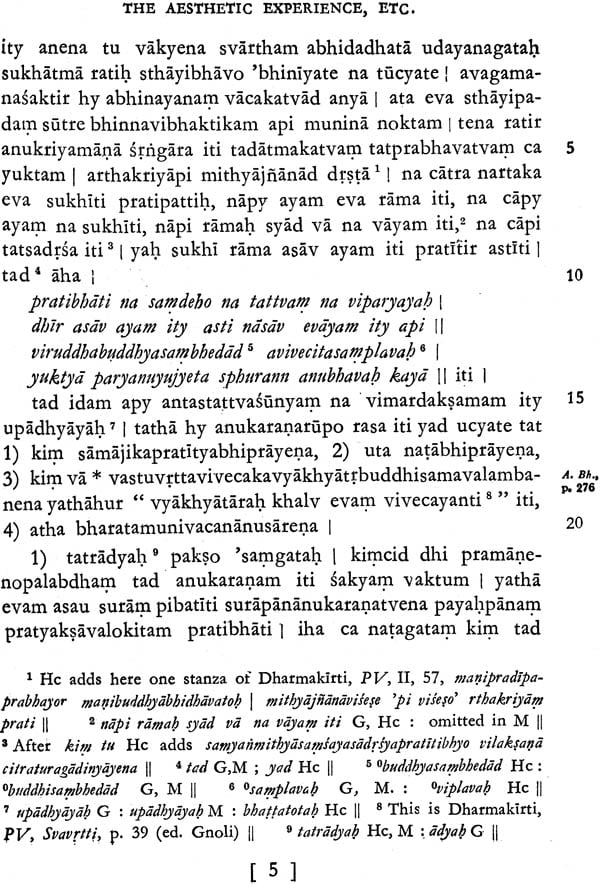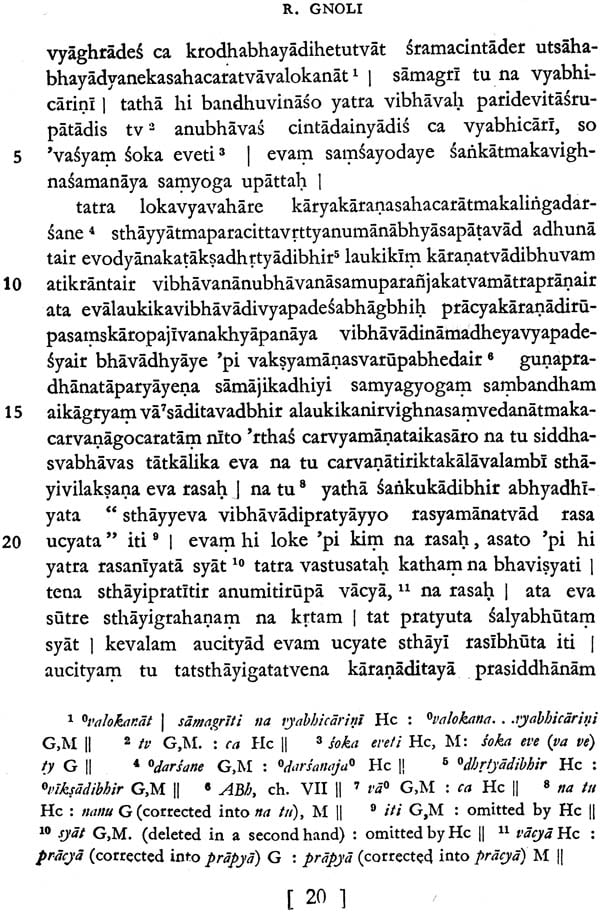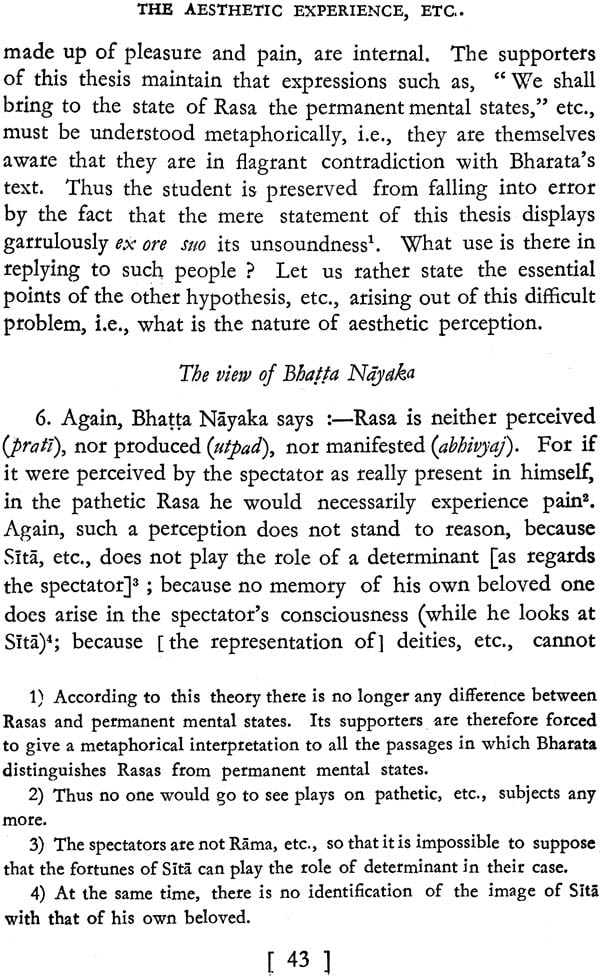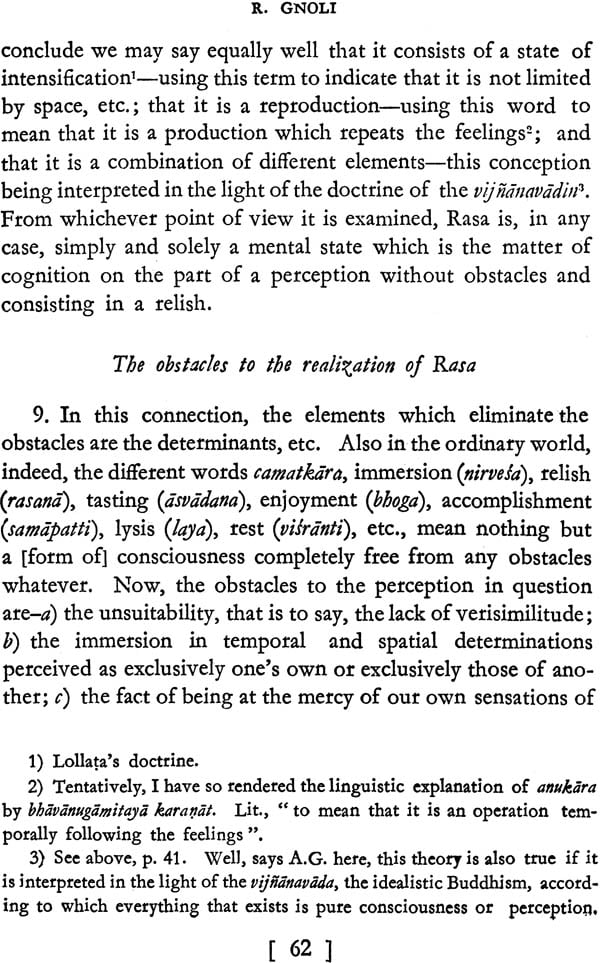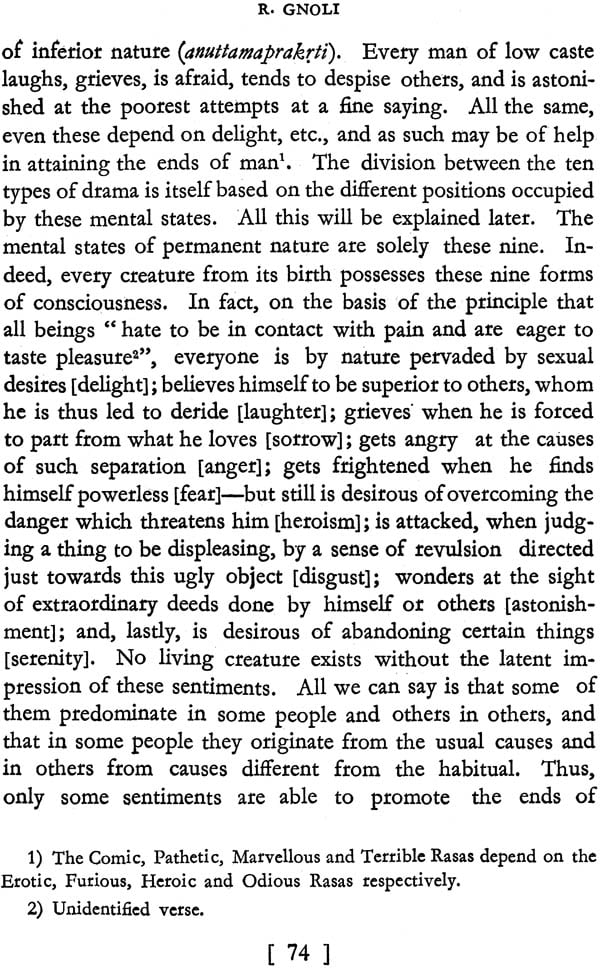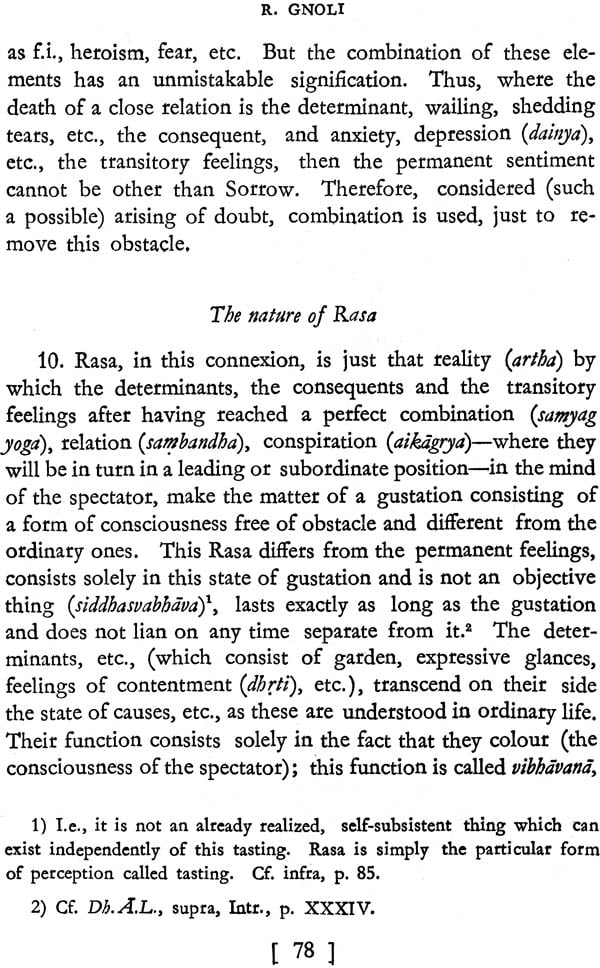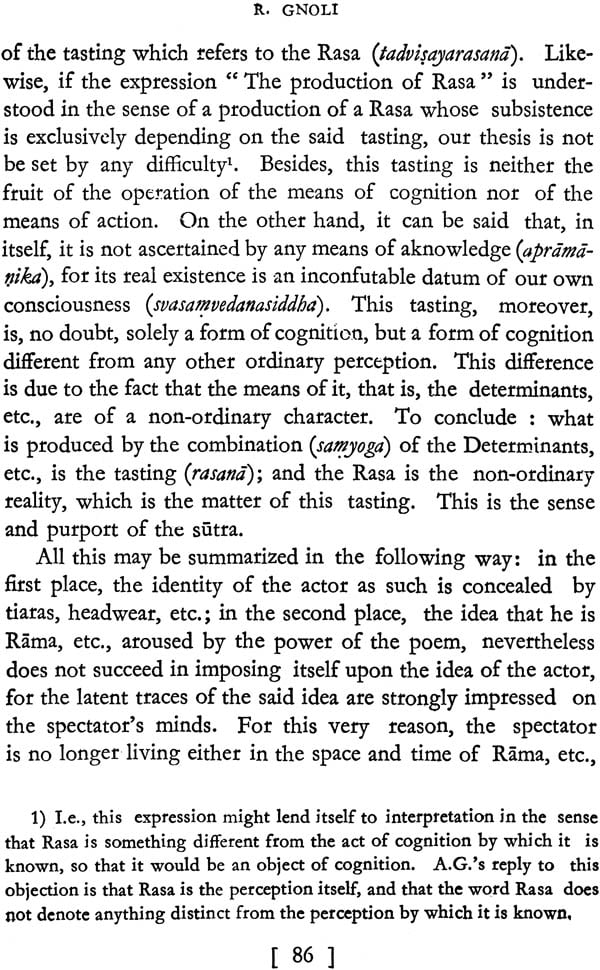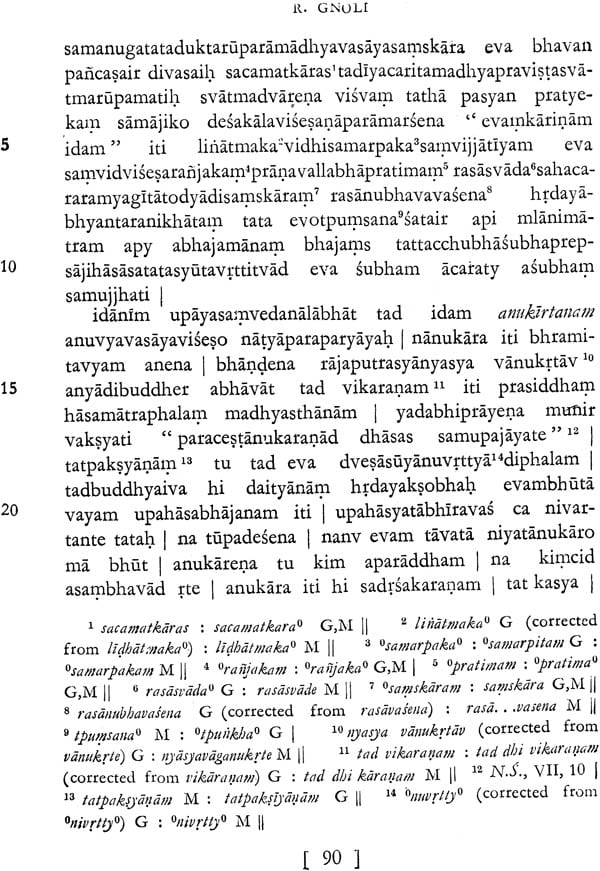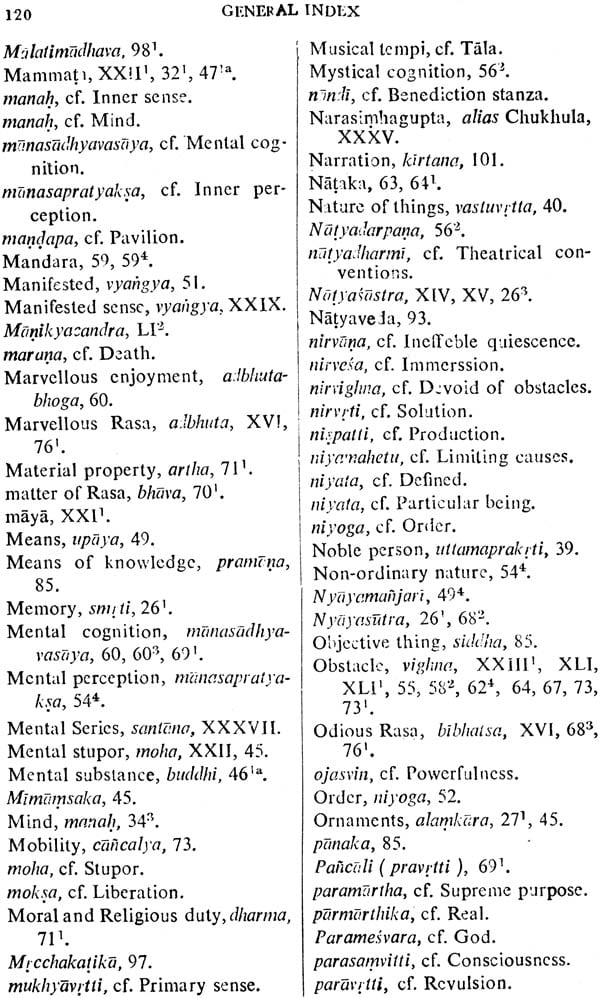
The Aesthetic Experience According to Abhinavagupta: Chowkhamba Sanskrit Studies Vol. LXII
Book Specification
| Item Code: | IDE291 |
| Author: | Raniero Gnoli |
| Publisher: | Chowkhamba Sanskrit Series Office |
| Language: | English |
| Edition: | 2015 |
| ISBN: | 9788170800064 |
| Pages: | 177 |
| Cover: | Paperback |
| Other Details | 9.8" X 6.2" |
| Weight | 260 gm |
Book Description
From the Jacket:
Bharata in his famous aphorism 'Vibhavanubhava-vyabhicarisamyogad rasanispattih' explains the way in which the Aesthetic experience originates and the Commentary thereupon by Abhinavagupta constitutes the most important text in the whole of Indian aesthetic thought. This important portion of the Commentary has very ably been edited, translated, commented upon and elucidated by Dr. Raniero Gnoli of Rome. The learned introduction contains all possible informations regarding various Indian and Western theories on aesthetic experience and in the copious notes the readers will find authentic materials quoted from numerous allied texts in justification of the interpretation of the difficult passages.
This book was first printed in 1956. Since then I have never relinquished my researches in the fields of Indian Rhetoric and Aesthetics. Some misinterpretations and mis- takes occurring in the first edition have already been corrected by myself in 1957, in the paper Further Observations On the Abhinavabbarati, East and west, year VIII, N. 1.-April, 1957 pp. 100-103. This new edition represents, I trust, a great im- provement in regard to the first one. The Introduction, the critical apparatus, the translation and the notes have been completely revised. The basic text of Abhinavagupta, i.e, the commentary to the famous sutra by Bharata, VI, after st. 31, vibhavanubhavavyabhicarisamyogad rasanispattib, has been supple; mented by three new texts, viz. the Commentaries on Natyasastra, I, st. 107, on Dhvanyaloka, I, st. 18, and II, st. 4. As to the text I have directly compared the MS of .Abbina- vabharati preserved in the library of Madras (M). References to the Kavi's edition of the .Abhinavabharati are to the second edi- tion of it. The letters He and M. C refer to the viveka of Hemacandra and to the samketa of Manikyacandra respectively. Although the additions and explanations of He do not alter in any way the thought of AG., I have not reproduced them in the text, which I have tried to set forth such as it was before the exegetical activity of the great jaina scholar.
In so many changes, one thing has remained unchanged in these ten years : I mean the profound debt of gratitude I owe to Prof. Giuseppe Tucci, to whom, now as then, this book is dedicated.
1. In India, the study of aesthetics-which was at first restricted to the drama-draws its origin from no abstract or disinterested desire for knowledge but from motives of a purely empirical order. The most ancient text that has come down to us is the Natyasastra (4th or 5th Century A. D. ?), ascribed to the mythical Bharata. This is a voluminous collec- tion of observations and rules concerned in the main with the production of drama and the training of actors and poets. The author, or the authors, with a certain sententiousness and ped- antry typical of Indian thought, classify the various mental states or emotions of the human soul and treat of their transi- tion from the practical to the aesthetic plane. The Natyasastra is a work of deep psychological insight. Drama appeals to sight and hearing at the same time (the only senses that are capable, according to some Indian thinkers, of rising above the boundaries of the limited " I ") and is then considered the highest form of art. In it both sight and hearing collaborate in arousing in the spectator, more easily and forcibly than by any other form of art, a state of consciousness sai generis, conceived intuitively and concretely as a juice or flavour, called Rasa. This typically Indian conception of aesthetic experience as a juice or a taste savoured by the reader or spectator should not surprise us. In India, and elsewhere, sensations proper to the 'Senses of taste and touch, almost devoid of any noetic representation, arc easily taken to designate states of conscious- ness more intimate and removed from abstract representations than the ordinary one-that is the aesthetic experience and va- rious forms of religious ones.
This Rasa, when tasted by the spectator, pervades and en- chants him. Aesthetic experience is, therefore, the act of tasting this Rasa, of immersing oneself in it to the exclusion of all else. Bharata, in a famous aphorism which, interpreted and elaborated in various ways, forms the point of departure of all later Indian aesthetic thoughts, says, in essence, that Rasa is born from the union of the play with the performance of the actors. "Out of the union of the Determinants-he says literally-, the Consequents and the Transitory Mental States, the birth of Rasa takes place". What is then the nature of Rasa? What are its relations with the other emotions and states of consciousness? And how are we to understand this word "birth"? The whole of Indian aesthetics hinges on such questions, which have been an inexhaustible source of polemic material to generations of rhetors and thinkers, down to our own days. But, before undertaking an examination of their various interpretations, let us briefly expound here the essentials of the empirical psychology of Bharata,
According to the Natyasastra, eight fundamental feelings, instincts, emotions or mental states called bhava or sthayibhava1 , can be distinguished in the human soul : Delight Laughter Sorrow Anger Heroism Fear Disgust and wonder These . eight states are inborn in man's heart. They permanently exist in the mind of every man, in the form of latent impressions derived from actual experiences in the present life or from inherited instincts, and, as such, they are ready to emerge into his consciousness on any occasion. In ordinary life each feeling is manifested and accompanied by three elements, causes effects and concomitant elements The causes are the various situations and encounters of life, by which it is excited ; the effects, the visible reactions caused by it and expressed by our face, our gestures and so on; and the concomitant elements, the accessory and temporary mental states accompanying it. These eight bhavas, indeed, do not appear in a pure form. The various modulations of our mental states are extremely complex, and each of the fundamental or permanent states appears in association with other concomitant mental states, as Discouragement, Weakness, Apprehension and so on. These occasional, transitory, impermanent states are, according to Bharata, thirty six. These same causes, etc., being acted on the stage or described in poetry, not lived in real life, give spectators the particular pleasure to which Bharata gives the name of Rasa. The fundamental mental states being eight in number, there are also eight Rasas, i.e., the Erotic the Comic the Pathetic the Furious the Heroic the Terrible the Odious and the Marvellous Later speculation generally admits a ninth permanent feeling, Serenity the corresponding Rasa is the Quietistic When they are not part of real life but are elements of poetical expression, even the causes, effects and con- comitant elements, just as the permanent mental states, take another name and are called respectively Determinants Consequents and Transitory Mental States Of course, from the spectator’s point of view, the consequents do not follow the feeling, as they do in the ordinary life, but they act as a sort of causes which intensify and prolong the feeling, brought about by the determinants.
2. dandin and bhatta Lollata. Bharata's text and the afore- said aphorism in particular became, as we have said, the subject of study and analysis for a whole series of thinkers, each of whom was anxious to contribute to a clearer understanding of the words of the Master. The earliest of these were, so far as is known, Dandin (7th century) and Bhatta Lollata (9th Cent.), who like his great successor, was a Kashmiri and probably a follower of one of the Sivaite mystical schools flourishing in Kashmir. According to them, Rasa is simply the permanent mental state (anger, fear, etc.) raised to its highest pitch by the combined effect of the Determinants, Consequents and Transi- tory Mental States. Bhatta Lollata maintains that Rasa lies both in the represented personage and in the imitating actor. The actor he says, feels the different bhavas and rasas as though they belonged truly, or rather personally, to him. To the objection that, being it so, the actor would fail to maintain or follow the tempo and the other dramatical conventions, Bhatta Lollata answers that, on the contrary, the actor can manage very well with them by virtue of anusamdbi or anusam- dhana1• Anusamdbi-that literally signifies recollection, me- mory and even something more than this, i.e., consciousness, awareness, reflection, etc.2 and I have tentatively rendered by " realisation "3-is at the same time the power thanks to which the actor "becomes " for the time being the represented or imitated personage (e.g. Rama), feels himself as Rama, and the faculty through which he nevertheless does not forget his real nature of actor. Seemingly, Bhatta Lollata's theory does not concern the problem of how the spectators do relish Rasa.
| List of Abbreviations | ix |
| Preface | xiii |
| Introduction | xiv |
| Text | 3 |
| Translation | 23 |
| Appendix I | 88 |
| Appendix II | 102 |
| Appendix III | 107 |
| General Index | 115 |
